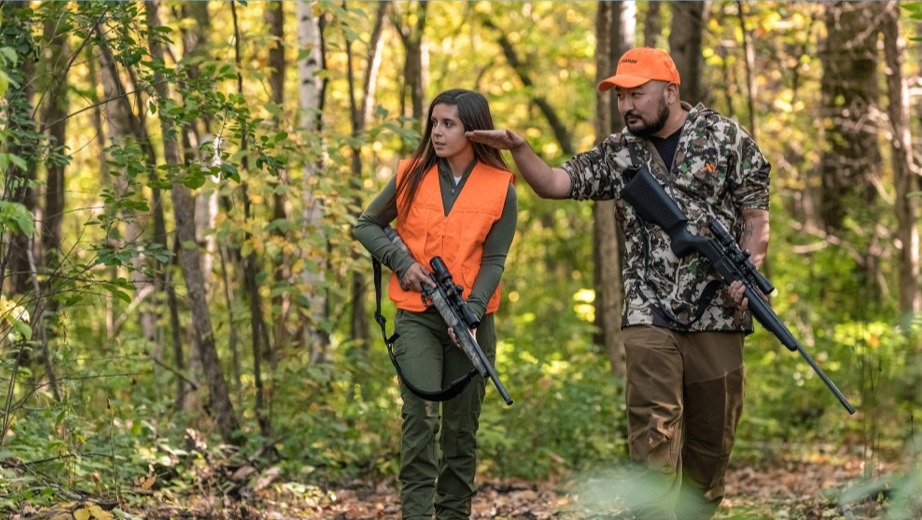R3 Foundations and Definitions
What is it?
At its most basic level, a recruitment, retention, or reactivation (R3) effort aims to influence or modify human behavior, specifically as it relates to outdoor activities. For the purposes of this Guide, the goal of R3 is to increase or maintain participation in and support for hunting and the shootings sports.
This chapter presents information and resources relevant to the strategies, methods, and basic principles of how an organization can most effectively incentivize someone to maintain or increase their hunting or shooting sports-related activities. It is designed to onboard new R3 practitioners and other vested staff to R3.
If you are new to R3, start at the beginning by reading the content and exploring the resources for one section before moving on to the next. By the time you have finished this chapter, you will have a solid understanding of basic R3 principles.
Other sections in this Guide provide the in-depth research, tools, partnerships, communication considerations, and other information necessary to plan, implement, and evaluate your organization’s R3 efforts. Still, building all of that on a solid foundation is very important. Read on!
Why is it Important?
Maintaining and/or increasing hunting and shooting sports participation is important because:
- An excise tax on firearms, ammunition, and archery equipment combined with hunting license sales provide the majority of funding for most state wildlife agencies..
- Equipment and travel expenses associated with hunting and shooting sports generate billions of dollars for the national economy and support hundreds of thousands of jobs every year.
- Hunting, shooting sports, and associated outdoor activities are enjoyed by millions of people and offer opportunities to maintain a connection with nature.
- Hunting is an important wildlife management tool, providing ecological benefits to all citizens.
- Hunters provide essential social and political support for conserving animals and habitats.
Before the early 2010s, the R3 efforts used by most agencies and organizations were primarily determined by the perceptions, expectations, or personal experiences of the individual staff implementing the efforts. Very few R3 efforts had been designed to incorporate the target audience’s needs, desires, or preferences. Nor were they constructed with any understanding of the participant’s cognitive hierarchy consisting of existing values, attitudes, or social norms. - Hunting is a natural activity that evolved with humans and provides an opportunity to harvest sustainable, locally-harvested protein
- Firearm ownership and shooting sports participation are core components of American culture and the lives of millions of people
Since 2010, the R3 community has developed a much better understanding of how people adopt new or different behaviors. This understanding helps show how an organization can influence the processes that lead to participation in hunting and shooting sports.
What is R3? (CAHSS “Start with a Solid R3 Foundation” Video Series)
This video offers a brief explanation of R3. It helps address why hunting and shooting sports are important.
Why Hunting and Shooting Sports Are Important (CAHSS “Start with a Solid R3 Foundation” Video Series)
This video explains why hunting and shooting sports are important.
How Can Your Organization Help Its Practitioners?
- Support staff time spent on R3 training and education
- Fund and host internal staff training from national R3 experts (e.g., WMI, CAHSS, RBFF, DJ Case).
- Allow staff to attend the National R3 Symposium and other opportunities for training and networking.
- Be clear about your R3 objectives (and how you will measure R3 success), so your R3 staff knows what they are working toward.
- Provide direct access to electronic license sales information to the R3 Coordinator/Team.
- Provide access to a supervisory team that provides support and resources for implementing R3.
- Support staff access to R3 marketing expertise (recognize that often the expertise needed to market R3 is beyond the capability of “normal” outreach staff).
- Require the use of R3 best practices when implementing R3 efforts.
- Help staff engage and partner with other R3-vested organizations and agencies.
Current Trends in Hunting and Shooting Sports Populations and Demographics
R3 practitioners and the leaders of R3-vested organizations must thoroughly understand the demographic composition and trajectory of Americans who hunt and target shoot. This knowledge can provide a valuable foundation for organizational R3 strategies by helping R3 practitioners prioritize target demographics for current and future R3 efforts.
NATIONWIDE RESIDENT HUNTING

The resources below examine the national demographic and social trends that impact hunting, angling, and shooting sports participation. R3 practitioners should note that hunter, angler, and, to some degree, recreational shooting participant populations are a dynamic collection of individuals who are highly influenced through time by Age, Period, and Cohort effects (see “The New Future of Hunting and Fishing Report” listed below for a full review of these effects and their impacts on hunters and anglers). R3 practitioners should understand these effects and use these resources to gain a working knowledge of where the nation’s hunters, anglers, and recreational shooting participant populations are headed, and thus, where to target their R3 strategies to get ahead of inevitable demographic changes.
Why Hunting and Shooting Sports Are Important (CAHSS “Start with a Solid R3 Foundation” Video Series)
This video explains why hunting and shooting sports are important. It is excellent material alongside reading about current trends in hunting and shooting sports.
2022 National Survey of Fishing, Hunting, and Wildlife-Associated Recreation
This resource helps identify recent and current trends in hunting and shooting sports.
The New Future of Hunting and Fishing (2022)
A forecasting model to predict license sales and guide financial decisions for fish and wildlife agencies as current high-participation demographics age.
Understanding and Using the Outdoor Recreation Adoption Model
Research from the Wildlife Management Institute (WMI) in 2009 highlighted a concerning trend among existing state and national R3 efforts. These efforts “were generally designed and implemented with very little consideration given to: a) identifying the audiences most in need of an R3 effort, b) the specific type of content or experiences a target audience needed before adopting the activity being promoted, or c) an evaluation system capable of documenting the effectiveness of the R3 effort being delivered (Wildlife Management Institute, 2009).”
Thus, noted the authors, “numerous R3 programs arose and were replicated without the guidance of needs assessments, target audience identification, or effectiveness measures.”
Moreover, it became clear that virtually none of these efforts had been designed with human behavior theory as a foundation. Instead, “R3 efforts were primarily developed according to the beliefs and opinions of the individuals or organizations implementing them.”
Social Support

In 2012, a working group of national R3 experts and R3-vested organizations recognized this deficiency. The group asserted that an effective R3 effort must be designed to address the needs of a target audience according to which specific stage of “adoption” that particular audience was in.
This recognition led to the development of what became known as the Outdoor Recreation Adoption Model (ORAM). At its core, the ORAM is “a theoretical framework with the purpose of helping the R3 community better understand the theory of how individuals might adopt new outdoor recreation activities” (Byrne and Dunfee, 2016). Additionally, it provides a social science-based delineation of the differences between recruitment, retention, and reactivation (see “Evolution and Current Use of the Outdoor Recreation Adoption Model” in the resources below). It is critical to note that the ORAM is based on more than 60 years of research documenting why and how people and cultures adopt certain activities or ideas. In a linear fashion, the ORAM illustrates the steps that individuals move through as they learn about, try, and then adopt a new activity or behavior. By understanding the ORAM and the processes critical to adoption of a new activity, R3 practitioners can build strategies that increase the reach and impact of their R3 efforts.
The ORAM can be extremely helpful to R3 practitioners in identifying where their efforts address a participant’s progress through the adoption process. It also can be helpful in developing more effective R3 strategies and in implementing comprehensive R3 efforts. (See the publication, “R3 and Outdoor Recreation” included in the table of resources below). For example, if the majority of an organization’s R3 efforts only provide hunting knowledge, skills, and a first trial, the participants are likely in need of next steps and additional resources to continue the process of becoming a hunter. Similarly, if an organization has no efforts targeting individuals who lapse, their efforts may be limited in long-term effectiveness as recruited or retained hunters continue to lapse over time. In these and other applications, R3 practitioners can use the ORAM to “map” their efforts (see “Mapping R3 Efforts on the Outdoor Recreation Adoption Model” in the resources below). This mapping process can help identify where gaps may exist in their R3 efforts. It can also help strategically link individual R3 efforts together, and to prioritize needs for new R3 efforts and resources. By understanding these concepts, practitioners will improve the impact of their R3 efforts.
Why Hunting and Shooting Sports Are Important (CAHSS “Start with a Solid R3 Foundation” Video Series)
This video explains why hunting and shooting sports are important. It is excellent material alongside reading about current trends in hunting and shooting sports.
CAHSS “Start with a Solid R3 Foundation” Video Series 3. What is the ORAM?
This video explains the ORAM and its use in R3.
Evolution and Current Use of the Outdoor Recreation Adoption Model
This resource helps define, outline, and apply the ORAM.
Mapping R3 Efforts on the Outdoor Recreation Adoption Model
An overview of how to use the ORAM to map R3 efforts. It helps provide a foundation for evaluating programs.
Natural Pathways: A Project of the Association of Fish and Wildlife Agencies North American Conservation Education Strategy
The Natural Pathways report documents real-world examples of using the Outdoor Recreation Adoption Model (ORAM) and results chains to evaluate (i.e., prove and/or improve) their efforts.
R3 and the Outdoor Recreation Adoption Model
Brief description of R3 and the steps of The Outdoor Recreation Adoption Model.
Common R3 Definitions
Without common definitions, it is nearly impossible to coordinate a national R3 effort. It is also very difficult to train new practitioners. Many of the definitions below are excerpts from the “R3 Metrics” white paper developed by the Western Association of Fish and Wildlife Agencies’ R3 Evaluation Criteria Working Group or from the National Dashboard. The latter are marked with an asterisk to denote their source.
Agency – For this discussion of R3, an agency is defined as a federal, tribal, state, municipal, or other governmental entity in charge of the conservation and management of fish and wildlife.
R3 – An acronym for the words “recruitment, retention and reactivation”; it refers to a series of efforts intended to modify participant behaviors to cause increased or maintained participation in target activities (e.g., boating, fishing, hunting, recreational shooting, etc.).
Recruitment – A behavioral influence (from an R3 effort or other external influence) resulting in the initial choice to participate in a target activity.
Retention – A behavioral influence (from an R3 effort or other external influence) resulting in continued year-to-year participation in a target activity.
Reactivation – A behavioral influence (from an R3 effort or other external influence) resulting in the renewed participation in an abandoned target activity
Churn rate – The proportion of a total participant population who do not participate in a target activity (as indicated by license purchase patterns or other participation metrics) in a given year or years.
*Individual organizations could define the amount of time a person has to spend without a license to consider them in your churn rate. The national dashboard calculates churn rate as the percentage of prior year license holders that were not license holders in the reporting year.
*License Holder/Participant – an individual who holds one or more licenses granting primary privileges for that activity. The National Dashboard counts any individual hold his/her license for at least one day as a license holder.
*License Rate: the percentage of the population for the reporting state or region that were license holders for the reporting period. The National Dashboard counts any individual hold his/her license for at least one day as a license holder.
Lapsed participant – An individual who does not participate in a target activity in the year, or years, after they previously participated.
*Individual organizations could define the amount of time a person has to be without a license to consider them in lapsed. The national dashboard calculates an individual as lapsed if she/he had a license for at least one day of the prior licensing period and does not have a license in the current licensing period. (based on churn def)
Reactivated participant – A lapsed participant who did not participate in a target activity in the previous year or years, and then resumes participation in the current year.
Reactivation Rate – The proportion of lapsed participants who did not participate in a target activity in the previous year or years, but then resumed participation in the current year.
Recruited participant – An individual who participates in a target activity for the first time. The National Dashboard considers a person who was a license holder in the reporting year, but was not a license holder in the 5 years prior a new participant/new recruit.
Recruitment Rate – The proportion of the participant population who participates in the target activity for the first time.
Retained participant – An individual who participates in a target activity in both the previous year and the current year.
Retention Rate – The proportion of individuals in a participant population who participated in a target activity in both the previous year and the current year.
Evolution and Current Use of the Outdoor Recreation Adoption Model
This resource helps identify and define words used in the ORAM.
R3 Outcomes and Evaluation Metrics
Evaluation is crucial to the long-term success of any R3 effort. It is such an important topic that we have dedicated an entire chapter of this Practitioner’s Guide to Evaluation & Monitoring. We strongly recommend that all R3 practitioners read this chapter.
General R3 Training Materials
In addition to the specific topics in this chapter, a wealth of more general material is available to R3 practitioners. We recommend you start with the CAHSS R3 practitioner resources available here R3 Resources – Shooting and Hunting Council (cahss.org). Then dig into the more considerable resources as time allows or when specific projects make them relevant.
1. Why Hunting and Shooting Sports Are Important (CAHSS “Start with a Solid R3 Foundation” Video Series)
This video explains why hunting and shooting sports are important. Foundational knowledge for R3.
2. What is R3? (CAHSS “Start with a Solid R3 Foundation” Video Series)
This video offers a brief explanation of R3. Foundational knowledge for R3.
Best Practices for R3 (CAHSS “Start with a Solid R3 Foundation” Video Series)
This video explains some of the best practices in R3. Excellent foundational training material.
Best Practices Workbook for Hunting and Shooting Recruitment and Retention
One of the earliest comprehensive tools for hunting and shooting recruitment and retention (R&R). This is a great training material resource.
CAHSS Basics of R3 Training
Videos that help you illustrate the context within which R3 functions, the importance of hunting and shooting sports, and the way that each of us is connected to the work of R3.
Community Resources for R3 (CAHSS “Start with a Solid R3 Foundation” Video Series)
This video guides viewers to some of the most helpful resources for R3 practitioners.
Hunting, Fishing, Sport Shooting, and Archery Recruitment, Retention and Reactivation: A Practitioner’s Guide
An expansive compilation of R3 survey/assessment results. This is a great training material resource.
National Hunting & Shooting Sports Action Plan: Strategies for Recruiting, Retaining and Reactivating Hunting and Shooting Sports Participants
This 36 page Action Plan provides national strategic guidance for R3 efforts. 2016
National R3 Implementation Workgroup Interim Report
The results of a 24-chair, five-month R3 implementation workgroup. Identified important R3 training considerations Pg. 50-52
Recommendations and Strategic Tools for Effective Angler Recruitment, Retention and Reactivation (R3) Efforts
This program evaluation guide was designed for aquatic educators. However, much is readily transferable to any R3 effort. Great training materials resource.






 massmonopoly
massmonopoly R3 PRACTITIONER’S GUIDE
R3 PRACTITIONER’S GUIDE